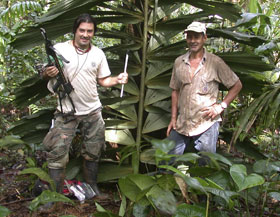Second-Growth Rain Forests
Lack Biodiversity, Say Biologists
 |
| Uzay Sezen, left, a graduate student, and field assistant Rigoberto Gonzales Vargas, with a downed Iriartea leaf for DNA sampling. |
|
Photo by U. Uzay Sezen |
The findings of three researchers in the Department of Ecology and Evolutionary Biology, published in the Feb. 11 issue of the prestigious journal Science, suggest that the next generation of tropical rain forests – those sprouting up around the globe where mature rain forests have been destroyed – may not be nearly as healthy as they seemed at first glance.
Initially, ecologists, including Professor Robin Chazdon, who has studied the regeneration of tropical rain forests in Costa Rica for 15 years, had been encouraged by the speed with which some species of trees were reappearing in areas once cleared for farming or ranching. But, in recent years, Chazdon and other scientists around the world have begun to question the biodiversity found in the newer rain forests they call “second-growth” forests.
Under the guidance of Chazdon and Professor Kent Holsinger, doctoral student Uzay Sezen applied the same DNA analysis techniques used in criminology and human paternity tests to determine parentage patterns in regenerating forests.
Although other scientists have begun studying the genetic diversity of second-growth forests, the trio’s study is ground-breaking because it is the first to pinpoint which trees in a mature rain forest parented offspring in a second-growth forest.
Their finding – that seeds from just two palm trees out of 66 found in a mature rain forest at La Selva Biological Station in Costa Rica produced more than half the founding generation of palms in a nearby, second-growth forest – points to a severe lack of genetic diversity and is cause for real concern, say Chazdon and Sezen.
“If this trend that we found is a common thing, then it’s something very serious,” Sezen says.
Tree populations that lack genetic diversity are far more susceptible to the effects of disease, pests, drought, and other global changes, Chazdon says, increasing the risk of extinction.
That possibility is particularly alarming because second-growth rain forests now outnumber mature rain forests, she adds.
“Most of the tropical forests we’re going to have left in the future are like this one,” she says. “It’s going to take a very long time to recreate the diversity found in a mature forest.”
The dissertation project began taking shape in 1999, when Chazdon took Sezen, then a prospective UConn student, on a tour of the La Selva Biological Field Station in Costa Rica, where she had established four long-term study plots in tropical second-growth rain forest sites. She told him she wished she could tell whether the trees in a nearby patch of mature rain forest were the parents of the second-growth trees. Sezen, who had a degree in molecular biology from Middle East Technical University in Turkey, replied it would be “no problem” to find out.
His research, which took more than two years, involved sampling DNA from the leaves of 196 palm trees. This was no easy task: it required using a crossbow loaded with fishing line to snag a nine-foot long palm leaf and pull it down to ground level. Sezen then brought the leaves to the field station laboratory, where he froze them in liquid nitrogen in order to extract DNA.
Back in Storrs, he used a DNA sequencer for DNA fingerprinting. Holsinger helped him use statistical procedures and software to analyze his data and identify which mature palms were the likely parents of the second-growth trees.
Chazdon says she hopes having this research published in Science will spur more people to study biodiversity in tropical forests in other parts of Central America, as well as South America, Africa, and Asia. “We need to determine what measures can be taken to foster as diverse a tree population as possible,” she says.
So far, Sezen, Chazdon, and Holsinger have studied the genetic make-up of just one species of palm tree in one part of Costa Rica, but the researchers believe the study has far-reaching implications. The particular palm – known as Iriartea – makes up 5 percent to 10 percent of the rain forest trees throughout Central and South America and is found from sea level to a height of 4,000 feet.
“It almost forms the backbone of the rain forest,” Sezen says.
Additionally, the study area, in a well-protected field station in Costa Rica, represents a best-case scenario for the regeneration of tropical rain forests, because the field station and adjacent Braulio Carillo National Park contain large areas of mature rain forests and have an abundance of birds and mammals to distribute the seeds that sprout new trees.
Publication of these findings comes on the heels of an international conference on biodiversity, held last month in Paris, where scientists and world leaders cautioned that plant and animal species are being lost at a rate 100 times faster than the average rate during the Earth’s history.

